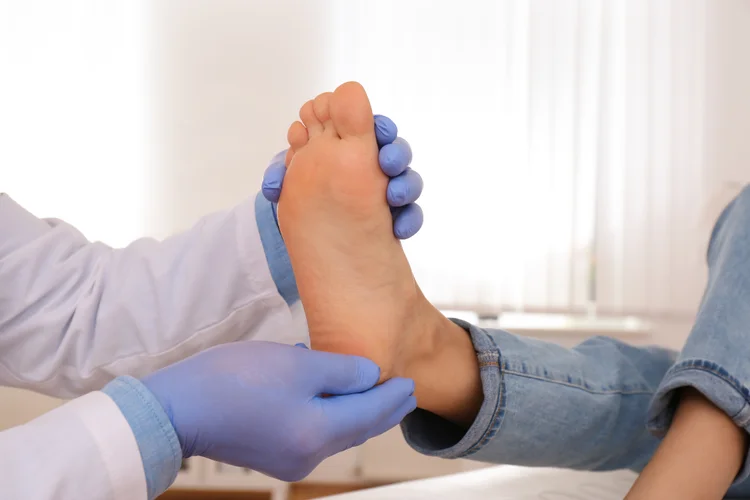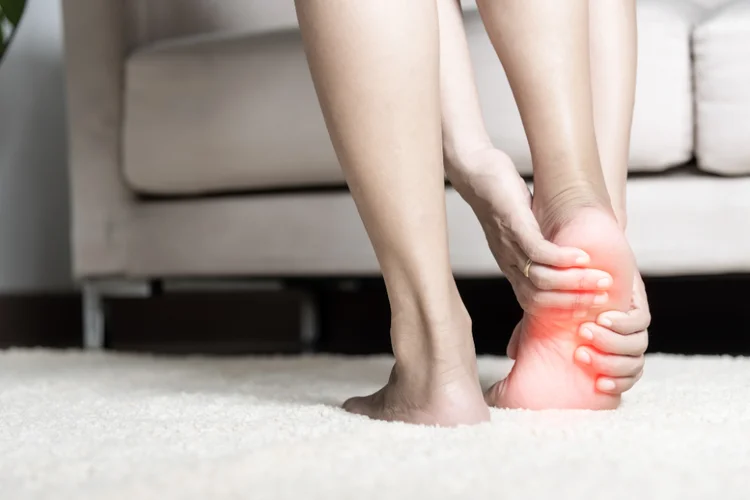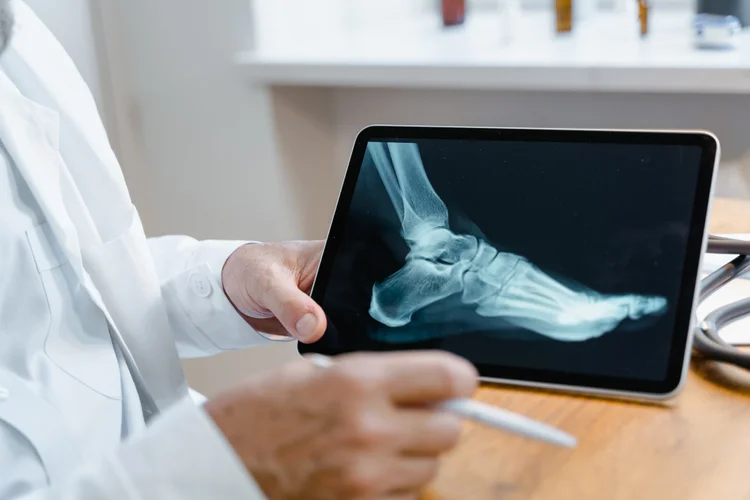Foot Doctor & Specialist Singapore
Foot conditions such as bunions, flat feet, or tendon pain can affect comfort and function. Dr Foo offers detailed assessment and personalised treatment, including non-surgical and surgical options to relieve symptoms and restore mobility.
MBBS (University of London) | MMed (Ortho) | FRCSEd (Ortho) | FAMS (Ortho)


What Does a Foot Doctor or Specialist in Singapore Treat?

An orthopaedic foot doctor or specialist in Singapore treats musculoskeletal conditions that
affect the bones, joints, ligaments, tendons, and muscles of the foot.
These include foot deformities, problems with alignment and movement, injuries from repeated
activity, age-related joint conditions, and injuries caused by accidents or impact.
At Apex Sports Clinic, our orthopaedic specialists assess and treat both structural and
functional foot problems. Our goal is to reduce pain, improve foot function, and
support your return to daily activities, whether that means walking
comfortably, standing for long hours, or performing at your desired level in training and
sport.
Common Foot Conditions We Manage
Foot conditions can develop due to abnormal foot mechanics, repeated stress, poor footwear,
underlying health conditions, or injury.
At Apex, we diagnose and manage a wide range of musculoskeletal foot issues, including:
Common Symptoms of Foot Conditions

Foot problems can cause a range of symptoms, from mild discomfort to significant pain or
mobility limitations, affecting your ability to walk, stand for long periods, or stay active
in daily or sporting activities.
Common signs to look out for include:
- Pain in the heel, arch, or forefoot, especially during walking or after periods of rest
- Swelling or tenderness in specific areas of the foot
- Stiffness or reduced range of motion in the foot or toes
- Difficulty bearing weight or limping during movement
- Numbness, tingling, or burning sensations in the toes or ball of the foot
- Visible deformities such as bunions, collapsed arches, or toe misalignment
- A sensation of instability, or feeling like the foot may give way
What to Expect During a Foot Specialist Consultation
At Apex Sports Clinic, we take a comprehensive approach that combines clinical assessment
with diagnostic imaging to identify the underlying cause of your symptoms and guide an
appropriate treatment plan.
This may include:
- Gait analysis and posture screening
- Range of motion and strength testing
- Joint and pressure point palpation
- Diagnostic Imaging such as X-rays or MRI, if a structural condition is suspected
Foot Pain Treatment Options Available
Treatment for foot conditions depends on the nature, severity, and impact of the condition
on your daily life, work, or sport.
We focus on conservative treatment methods aimed at restoring function and relieving symptoms. If
surgical intervention is necessary, our orthopaedic specialists provide care as part of a
comprehensive treatment plan.
| Treatment | Description & Purpose |
|---|---|
| Non-Surgical Management | |
| Activity Modification | Adjusting or reducing load-bearing or repetitive activities to minimise strain and allow healing. |
| Pain Management | Oral or topical anti-inflammatory medication to reduce pain and control inflammation in acute or chronic foot conditions. |
| Footwear Advice | Guidance on selecting suitable footwear to support foot structure, reduce pressure, and improve comfort. |
| Physiotherapy | Individualised exercises, manual therapy, and movement retraining to reduce pain and restore function. |
| Shockwave Therapy (ESWT) | Use of acoustic pressure waves to stimulate blood flow, promote tissue regeneration, and reduce chronic pain. |
| Image-Guided Injections | Targeted administration of corticosteroids or platelet-rich plasma (PRP) to reduce inflammation and support recovery. |
| Surgical Intervention | |
| Morton’s Neuroma Excision | Surgical removal of thickened nerve tissue when conservative measures fail to relieve pain. |
| Bunion Correction Surgery | Realignment of the big toe joint to address significant deformity and pain in hallux valgus. |
| Heel Spur Surgery | Removal of persistent bony growths on the heel when conservative treatments do not provide relief. |
| Tendon or Ligament Repair |
Surgical reconstruction of torn or damaged soft tissues, typically following trauma or
degeneration.
Commonly used to treat:
|
| Fracture Fixation | Internal stabilisation of foot fractures using screws, plates, or pins to restore bone alignment and function. |
When Should You See a Foot Specialist?

You should consider seeing a foot specialist if you experience persistent foot pain,
swelling, numbness, or visible changes in foot structure that affect your daily
activities or mobility.
Signs that may warrant medical attention include:
- Persistent discomfort despite footwear changes or activity modification
- Recurring injuries or overuse symptoms related to walking, work, or sport
- Progressive deformities, such as worsening bunions or arch collapse
- Delayed recovery after a fall, sprain, or suspected fracture
- Foot issues associated with a broader musculoskeletal condition or medical diagnosis (e.g. arthritis, diabetes with joint impact)
Even if symptoms appear mild, a proper evaluation can help identify problems with foot alignment or early joint wear that may benefit from timely treatment.
Choosing the Best Foot Doctor in Singapore
Selecting the right foot doctor depends on your specific condition, activity level, and treatment goals. It’s important to consider:
- Clinical Focus – Some doctors specialise in sports injuries, while others manage structural deformities, chronic pain, or joint conditions.
- Diagnostic Capability – Access to imaging such as X-rays or MRI can support a more detailed evaluation and timely diagnosis.
- Treatment Philosophy – Look for an approach that includes both non-surgical options, such as physiotherapy and insoles, and surgical care when clinically appropriate.
- Rehabilitation Support – Ongoing care, including physiotherapy and return-to-activity planning, is key for long-term recovery.
The most suitable doctor for you is one whose expertise and care approach align with your condition
and recovery goals.
If you are unsure where to begin, a consultation can help
assess your needs and guide you towards appropriate care options.
Every patient deserves a treatment plan tailored to their needs. We start with non-surgical approaches before considering more invasive interventions.
Find a Foot Doctor & Specialist Near Me
Apex Novena
admin@apexsportsclinic.sg
101 Irrawaddy Rd, #18-12 Royal Square Medical Centre, Singapore 329565
Nearest MRT: NS20 Novena
Apex East Coast
admin@apexsportsclinic.sg
112 E Coast Rd, #03-03/04 i12 Katong, Singapore 428802
Nearest MRT: TE26 Marine Parade
Why Do Patients Choose Apex Sports Clinic?
Sports Doctor in Singapore: Personalised & Affordable Care
Progressive Treatment Philosophy
We prioritise personalised, non-invasive solutions, progressing to specialised treatments, including surgery, only when needed for more effective and targeted care.
Holistic Patient-Centred Care
From diagnosis to rehabilitation, we provide comprehensive and seamless care for a wide range of orthopaedic conditions.
Specialist in Sports Orthopaedics & Injury Management
We combine expert injury management with a proactive approach to maintaining your body’s strength and function, so you can recover fully and perform at your peak.
Patient Journey
1 . Schedule Your Appointment

2 . Expert Diagnosis & Consultation

3 . Customised Treatment Plan

Schedule an Appointment

Our Insurance Partners






Frequently Asked Questions (FAQs)
A foot doctor is a healthcare professional who diagnoses and treats conditions affecting the foot. In Singapore, this generally refers to either a podiatrist or an orthopaedic foot specialist. Podiatrists manage skin, nail, and non-surgical musculoskeletal issues such as flat feet and tendon pain, while orthopaedic specialists focus on musculoskeletal conditions that may involve structural deformities, joint degeneration, or surgical intervention.
Yes, a general practitioner or another healthcare provider can refer you to a foot specialist based on your symptoms. Referral may be made to a podiatrist for musculoskeletal conditions managed non-surgically, such as flat feet or tendon pain, or to an orthopaedic foot specialist for structural deformities, injuries, or conditions that may require surgical assessment.
Seven common orthopaedic foot problems include plantar fasciitis, bunions, flat feet, Morton’s neuroma, metatarsalgia, heel spurs, and stress fractures. These conditions can cause pain, deformity, or reduced mobility, and often result from overuse, altered foot mechanics, or underlying musculoskeletal issues. It is advisable to seek medical evaluation if symptoms persist, worsen, or interfere with daily activities.
The most appropriate doctor to see for foot pain depends on the underlying cause. Podiatrists manage non-surgical issues such as skin, nail, and alignment-related problems, while orthopaedic foot specialists treat conditions involving bones, joints, and soft tissues, especially when structural issues or surgery may be required.
The medical term for a foot specialist may refer to either a podiatrist or an orthopaedic foot surgeon, depending on the nature of the condition. Podiatrists specialise in diagnosing and managing non-surgical foot and ankle problems, while orthopaedic foot specialists are medical doctors who treat bone, joint, and soft tissue conditions, including injuries and structural deformities.
The main difference is that podiatrists are trained to manage foot and ankle conditions without surgery, while orthopaedic foot specialists are medical doctors who treat musculoskeletal problems and perform surgery when required. Both can diagnose and manage foot issues, but they differ in their training, clinical scope, and approach to treatment.
Foot problems may be managed by either a podiatrist or an orthopaedic foot specialist, depending on the condition. Podiatrists treat skin, nail, and non-surgical structural issues, while orthopaedic foot specialists address musculoskeletal conditions such as injuries, deformities, and joint problems, often including surgical care when needed.

